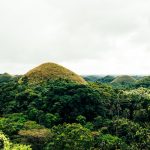Download links
How to install Exploring the Majestic Chocolate Hills of fb777 APK?
1. Tap the downloaded Exploring the Majestic Chocolate Hills of fb777 APK file.
2. Touch install.
3. Follow the steps on the screen.
Description
The Chocolate Hills, a geological wonder located in the Bohol province of the Philippines, are a striking natural formation that has intrigued scientists and tourists alike. These hills, numbering over 1,200, are characterized by their conical shapes and uniformity, rising dramatically from the surrounding landscape. The formation of these hills is attributed to a combination of geological processes that took place over millions of years.
Over time, tectonic activity caused the land to uplift, exposing the limestone to erosion. The unique topography of the Chocolate Hills is a result of both chemical and physical weathering.
Rainwater, slightly acidic due to dissolved carbon dioxide, seeps into the limestone, gradually dissolving it and creating a series of depressions and valleys. This process, known as karst topography, is responsible for the distinctive shapes of the hills. The hills are not volcanic in origin; rather, they are remnants of a once vast limestone plateau that has been sculpted by natural forces.
The result is a landscape that appears almost surreal, with hills that change color with the seasons—from lush green during the rainy season to a rich brown hue in the dry season, resembling chocolate mounds.
Key Takeaways
- The Chocolate Hills were formed by the uplift of coral deposits and the action of rainwater and erosion over millions of years.
- The panoramic views from the Chocolate Hills offer a breathtaking sight of hundreds of conical hills stretching as far as the eye can see.
- The flora and fauna of the Chocolate Hills include a variety of plant species and wildlife, including the endangered tarsier and various bird species.
- The Chocolate Hills hold cultural significance to the locals, with legends and folklore surrounding their formation and existence.
- Visitors can enjoy activities such as hiking, zip-lining, and ATV rides in and around the Chocolate Hills, offering a range of adventures for nature enthusiasts.
- Conservation efforts are in place to preserve the natural beauty of the Chocolate Hills, including reforestation projects and sustainable tourism practices.
The Breathtaking Views from the Chocolate Hills
Stunning Views at Sunrise and Sunset
The scenery is particularly breathtaking during the golden hours of sunrise and sunset, when the light casts dramatic shadows and highlights across the hills, accentuating their contours and colors. Standing atop one of these hills is a humbling yet exhilarating experience, with the gentle undulations of the terrain evoking feelings of tranquility and the vastness of the landscape inspiring a sense of freedom and adventure.
A Photographer’s Paradise
The unique shapes and colors of the Chocolate Hills make them a photographer’s dream destination. Photographers flock to this location to capture its beauty, experimenting with different angles and perspectives to showcase the hills’ distinctive forms. The contrast between the vibrant greens of the surrounding vegetation and the earthy tones of the hills adds depth to photographs, making them popular on social media platforms.
Seasonal Charm
Each season brings its own unique charm to the Chocolate Hills. During the rainy season, the hills are cloaked in lush greenery, while in the dry season, they take on a more barren yet equally captivating appearance. Whether you visit during the wet or dry season, the Chocolate Hills are sure to leave a lasting impression.
The Flora and Fauna of the Chocolate Hills

The ecological diversity surrounding the Chocolate Hills is as remarkable as their geological features. The area is home to a variety of plant species that thrive in its unique environment. Grasses and shrubs dominate the lower slopes, while taller trees can be found in more sheltered areas.
The flora is adapted to withstand periods of drought, with many plants exhibiting xerophytic characteristics that allow them to conserve water. This adaptation is crucial given the region’s tropical climate, which can be characterized by distinct wet and dry seasons. In addition to its plant life, the Chocolate Hills are also a habitat for various animal species.
Birds are particularly abundant in this region; species such as the Philippine tarsier—a small primate known for its large eyes—can be spotted among the trees. These creatures play an essential role in maintaining the ecological balance by controlling insect populations and dispersing seeds. Other wildlife includes various reptiles and insects that contribute to the rich biodiversity of the area.
The presence of these species highlights the importance of preserving this unique ecosystem, as it supports not only local wildlife but also contributes to broader environmental health.
The Cultural Significance of the Chocolate Hills to the Locals
| Aspect | Metrics |
|---|---|
| Historical Importance | Believed to be the tears of a giant who lost his love |
| Local Legends | Various myths and stories passed down through generations |
| Tourism | Major attraction drawing visitors from around the world |
| Cultural Identity | Symbol of pride and identity for the local community |
For the people of Bohol, the Chocolate Hills hold deep cultural significance beyond their natural beauty. Local legends and folklore often revolve around these hills, enriching their historical context. One popular tale tells of a giant who fell in love with a mortal woman; after her death, he wept so profusely that his tears formed the hills we see today.
Such stories are integral to local identity and are passed down through generations, fostering a sense of pride among residents. Moreover, the Chocolate Hills have become a symbol of Bohol’s cultural heritage and tourism appeal. They attract thousands of visitors each year, providing economic opportunities for local communities through tourism-related activities such as guided tours, souvenir shops, and local cuisine offerings.
Festivals celebrating local culture often incorporate themes related to the hills, showcasing traditional music, dance, and crafts that reflect Boholano identity. This connection between natural landmarks and cultural expression underscores how intertwined geography and community can be.
Activities and Adventures in and around the Chocolate Hills
The Chocolate Hills offer a plethora of activities for adventure seekers and nature enthusiasts alike. Hiking is one of the most popular ways to explore this stunning landscape. Trails wind through and around the hills, allowing visitors to experience their beauty up close while enjoying fresh air and exercise.
Some trails lead to lesser-known viewpoints that provide a more intimate perspective on these geological formations away from crowded tourist spots. For those seeking a more adrenaline-pumping experience, ATV (All-Terrain Vehicle) rides are available in the area. These guided tours allow participants to navigate rugged terrain while enjoying breathtaking views from different angles.
Riding an ATV through this unique landscape offers an exhilarating way to appreciate its beauty while engaging in an adventurous activity. Additionally, some tour operators offer zip-lining experiences that provide a bird’s-eye view of the hills and surrounding countryside—an unforgettable way to take in the scenery.
Conservation Efforts to Preserve the Natural Beauty of the Chocolate Hills

As awareness grows regarding environmental issues globally, conservation efforts aimed at preserving natural wonders like the Chocolate Hills have become increasingly important. Local government units and environmental organizations have initiated programs focused on sustainable tourism practices that minimize human impact on this delicate ecosystem. These initiatives include regulating visitor numbers at key sites to prevent overcrowding and implementing guidelines for responsible behavior while exploring the area.
Education plays a crucial role in these conservation efforts as well. Local communities are engaged in awareness campaigns that highlight the importance of protecting their natural heritage for future generations. Schools often incorporate environmental education into their curricula, teaching children about biodiversity and conservation practices relevant to their surroundings.
By fostering a sense of stewardship among residents—especially younger generations—these initiatives aim to ensure that both locals and visitors appreciate and respect the unique beauty of the Chocolate Hills while contributing positively to their preservation. In conclusion, the Chocolate Hills stand as a testament to nature’s artistry and resilience. Their geological formation tells a story millions of years in the making, while their breathtaking views captivate all who visit.
The rich flora and fauna add layers of complexity to this landscape, supporting diverse ecosystems that thrive within its bounds. Culturally significant to local communities, these hills inspire legends and provide economic opportunities through tourism. With various activities available for adventurers and ongoing conservation efforts aimed at preserving this natural wonder, the Chocolate Hills remain an enduring symbol of Bohol’s beauty and heritage for generations to come.
If you’re interested in exploring more unique destinations like the Chocolate Hills, you may want to check out this article on Call of Duty Warzone Mobile.
You can read more about it here.
FAQs
What are the Chocolate Hills?
The Chocolate Hills are a geological formation in the Bohol province of the Philippines. They are made up of around 1,268 cone-shaped hills, which are covered in green grass that turns brown during the dry season, giving them the appearance of chocolate kisses.
How were the Chocolate Hills formed?
The exact formation process of the Chocolate Hills is still a subject of debate among geologists. However, it is widely believed that they are the result of the uplift of coral deposits and the action of rainwater and erosion over millions of years.
What is the best time to visit the Chocolate Hills?
The best time to visit the Chocolate Hills is during the dry season, which typically runs from late November to May. This is when the grass covering the hills turns brown, giving them their chocolate-like appearance.
Are there any activities to do at the Chocolate Hills?
Visitors to the Chocolate Hills can enjoy activities such as hiking, bird watching, and taking in the panoramic views from the viewing deck. There are also ATV tours and zip-lining available for those seeking a more adventurous experience.
Is there an entrance fee to visit the Chocolate Hills?
Yes, there is an entrance fee to visit the Chocolate Hills. The fee helps with the maintenance and preservation of the area.





